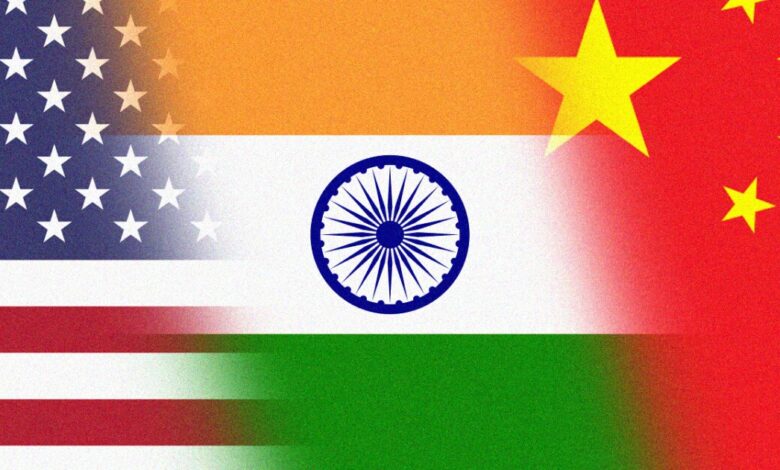Number of New Chinese Students at U.S. Colleges Plummeted This Fall, Visa Data Show

The number of U.S. visas issued to Chinese students for the new academic year plunged from pre-pandemic levels, an alarming development for American colleges that have come to rely on tuition dollars from a booming Chinese market.
Still, the total number of new student visas awarded for the fall of 2022 was up, thanks to surging demand from India, according to a Chronicle analysis of visa data collected by the U.S. Department of State.
More than 84,000 student, or F-1, visas were issued to Indian students during the critical months of May to August, the period that accounts for the bulk of student-visa issuances. That’s almost 45 percent more visas for Indian students than the same four months last year and a staggering 148 percent more than during that span of 2019.
India far outpaced China in newly issued visas. Only about 47,000 F-1 visas went to Chinese students this summer, 40,000 fewer than were issued from May to August 2021, a 45-percent decline.
Despite the precipitous drop in new visas, China remains the largest source of international students on American campuses. About 252,000 Chinese student-visa holders were in the United States in September, according to federal-government data, compared with some 241,000 Indian students.
Most international students are issued a single visa for the duration of their studies. And while elementary- and secondary-school children from abroad also come to the United States on F-1 visas, nine in 10 student-visa holders are college students, so visa data are largely a reflection of college enrollments.
From May through August, the State Department issued nearly new 282,000 F-1 visas at consulates worldwide, a 2-percent increase over the summer of 2021 and 10 percent more than the same period before the Covid-19 pandemic.
Softening Chinese Demand
The continuing post-Covid rebound among international students over all is a relief for American colleges — no other demographic group experienced as large an enrollment decline during the pandemic.
But the apparent collapse in Chinese-student interest in studying in the United States, whether temporary or permanent, is sure to undercut certainty in future international-enrollment trends.
The drop marks a significant reversal: In the dozen years before the pandemic, enrollments from China soared 450 percent. At their peak, one in three international students on American campuses was from China. One analysis, from the Institute of International Education, estimated that college students from China added $15.9 billion to the American economy during the 2019-20 academic year — and much of it benefited colleges’ bottom lines since most Chinese students pay the full cost of tuition.
But during the pandemic, economic activity generated by the “export” of American educational services to international students fell by almost 28 percent, or nearly $16 billion, according to the U.S. Department of Commerce.
The ability of Chinese students to travel to the United States was severely curtailed by the pandemic, more than that of other international students. The early outbreak of Covid in China led the U.S. government to impose a travel ban on visitors, including student-visa holders, from China in the first months of the pandemic, and it was not lifted until May 2021. As a result, any student coming from China had to first travel to a third country and quarantine. There were few flights between the two countries, and American consulates were closed. During the summer of 2020, only about 500 visas were issued to Chinese students.
Yet there are indications that softening Chinese demand for an American education is not solely driven by the pandemic. For one, Chinese families typically save for years for their children’s education, and many students who go abroad opt out of the national high-school curriculum that prepares them for admission to a Chinese university. As a result, students are locked into their plans to study overseas far in advance. For those students, the pandemic probably disrupted their American education but didn’t derail it altogether — indeed, visa issuances to China last summer rose above pre-pandemic levels, a sign of pent-up demand from students who had deferred admission.
Even before the pandemic, the rapid growth in Chinese enrollments had leveled off, and the number of new international students coming to the United States had been in decline. One big culprit: rising geopolitical tensions between the United States and China. Under the Trump administration, the White House considered a ban on Chinese students, and President Donald J. Trump reportedly called them spies. Public skepticism about enrolling large numbers of Chinese students has also grown. More than half of Americans in a 2021 Pew Research Center survey said they favored restrictions on students from China.
The students may be turning away from the United States to other popular destinations. Chinese applicants to British universities increased by 10 percent over the previous year. And because of the pandemic, some families may want their children to stay closer to home — Hong Kong universities are reporting record enrollments from mainland China.
Jon Santangelo, a spokesman and senior consultant for the Beijing Overseas Study Service Association, a group of recruitment agents in China, said the pandemic may have exacerbated existing concerns among Chinese students about the United States as a safe and welcoming destination. “Covid was probably an accelerant,” he said.
Economic factors may also be depressing interest, Santangelo said. The dollar’s rise in value relative to the Chinese renminbi and other foreign currencies has made an American degree much more expensive for Chinese students. China’s once-red-hot economy has cooled, particularly its housing market, which many middle-class families used to fund college expenses. And the job market for recent Chinese college graduates is bleak, which could make some students hesitate to gamble that an investment in a costly foreign degree will pay off.
Surging Interest From India
For American colleges, the record growth in visa issuances to Indian students goes a long way toward offsetting Chinese enrollment losses. It’s possible that the increase could have been even more robust if not for a substantial visa-application backlog in India. Current estimated wait times for student-visa appointments at American consulates in New Delhi and Mumbai are 430 days.
Several factors are likely at play in the increased demand from Indian students, said Rajika Bhandari, an expert in international-student mobility and author of America Calling: A Foreign Student in a Country of Possibility, which is about her own experience as a student from India. Such factors include a growing college-age population and too few top-quality universities to meet that demand. Online resources have given students outside India’s major cities better access to information about study abroad. And greater availability of student loans has made it possible for students from lower- and middle-income families to pay for a foreign degree.
However, one of the biggest drivers of interest among Indian students may be greater confidence that they can gain critical work experience along with their American degree. A recent survey of prospective Indian students found that career advancement and the chance to earn higher salaries were among the top three reasons for studying overseas.
Under President Trump, that pathway to work had seemed rockier. He repeatedly threatened to end a program that allows international students to temporarily stay in the United States after graduation to work, but his loss to Joseph R. Biden Jr. put the program, known as Optional Practical Training, on firmer footing. In January, President Biden announced an expansion of the program, to allow more students to work for longer times, and he has pledged to make it easier for international graduates of American colleges in science and technology fields to get green cards. Indian students now “feel more optimistic about their future prospects” in the United States, Bhandari said.
Shivam Sharma already has a job lined up, at Federal Express’s Memphis headquarters, when he graduates from nearby Christian Brothers University in December with a master’s degree in data science. Sharma, who is from Pathankot, a city in northern India, has enjoyed his American classes but said having overseas work on his résumé could give him a valuable edge among other job candidates when he returns home.
“With 1.5 billion of us in India,” he said, “the added experience helps.”
At Christian Brothers, a private Roman Catholic college, international graduate enrollments have increased from 55 in the fall of 2020 to 382 this fall, said Daniel S. Harper, dean of the graduate school and associate vice president for international initiatives. Almost all of the international students are from India.
Indeed, the growth in Indian enrollments will most likely benefit graduate programs, since nearly three-quarters of Indian students are enrolled at that academic level. The Council of Graduate Schools reported last month that in 2021 more students in master’s and certificate programs came from India than from any other foreign country.
Still, colleges may regard the growth in Indian students with some wariness. Indian enrollments have typically been more volatile than have those from China, posting both big gains and modest declines over the past decade.
And the falloff from China, long such a dominant source of international students in the United States, is a cautionary tale, a reminder of “how fragile enrollments can be and how they can shift very quickly,” Bhandari said. “I’d say not to put all your eggs in one basket.”
Source link






